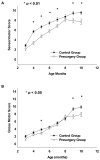Improvement in motor development following surgery for infantile esotropia
- PMID: 18083593
- PMCID: PMC2476213
- DOI: 10.1016/j.jaapos.2007.08.013
Improvement in motor development following surgery for infantile esotropia
Abstract
Purpose: Infantile esotropia is associated with abnormal visual development and thus may delay the achievement of developmental milestones. Although early surgery can improve visual function, less is known about its effect on motor development. Here we address whether early surgery can improve motor development.
Methods: Recently, our lab devised the Infant Developmental Skills Survey, a 25-item questionnaire designed to assess sensorimotor and gross motor development. The questionnaire was completed by the parents of 3- to 10-month-old patients with infantile esotropia prior to surgery (n = 143) and the parents of 6- to 11-month-old patients following surgery (n = 58). A subset of parents (n = 40) completed the questionnaire both before and after surgery. For comparison, the questionnaire was completed by the parents of infants with normal ocular alignment (n = 194).
Results: Before surgery 4-, 5-, 6-, 7-, 9-, and 10-month-old patients showed delayed achievement of sensorimotor milestones (p < 0.01), and 5-, 9-, and 10-month-old patients demonstrated delayed attainment of gross motor milestones (p < 0.05) compared with normal children. However, following surgery, patients demonstrated a greater rate of sensorimotor development than age-matched controls (p < 0.0001) and caught up with normal children on both sensorimotor and gross motor skills.
Conclusions: Prior to surgery, patients with infantile esotropia were delayed in their achievement of developmental milestones. However, following surgery, a comparison group of patients showed rapid development and possessed motor skills comparable to those of normal children, suggesting that early surgery is beneficial to both visual and motor development.
Figures


References
-
- Birch EE, Stager DR. Long-term motor and sensory outcomes after early surgery for infantile esotropia. J AAPOS. 2006;10:409–13. - PubMed
-
- Fawcett SL, Birch EE. Motion VEPs, stereopsis, and bifoveal fusion in children with strabismus. Invest Ophthalmol Vis Sci. 2000;41:411–6. - PubMed
-
- Birch EE, Salomao S. Infant random dot stereo acuity cards. J Pediatr Ophthalmol Strabismus. 1998;35:86–90. - PubMed
-
- Birch EE, Morale SE, Jeffrey BG, O’Connor AR, Fawcett SL. Measurement of stereacuity outcomes at ages 1 to 24 months: Randot® Stereocards. J AAPOS. 2005;9:31–6. - PubMed
Publication types
MeSH terms
Grants and funding
LinkOut - more resources
Full Text Sources
Medical
Miscellaneous

